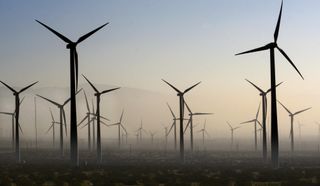Wind and solar power overtakes coal for the first time ever in the US
Wind and solar power produced a combined 252 terawatt-hours in the first five months of 2023, compared with coal's output of 249 TWh

Wind and solar power has generated more electricity than coal for the first time ever in the U.S, according to new federal data.
Wind and solar sources produced a combined 252 terawatt-hours in the first five months of 2023, compared with coal's output of 249 TWh, data from the U.S. Energy Information Administration (EIA) seen by E&E News has revealed. This marks the very first time that renewable energy has outperformed coal without including hydroelectric power in the count.
The milestone is a consequence of the continuing decline of coal usage in the U.S., as coal facilities shut down and are replaced by renewable energy and natural gas energy sources. At its peak in 2007, coal accounted for 49.9% of the U.S.'s energy production.
Related: Climate change could trigger gigantic deadly tsunamis from Antarctica, new study warns
"Our official estimates from the Electric Power Monthly show that combined electricity generation from wind and solar exceeded generation from coal in January, February and March," Chris Higginbotham, a spokesperson for the EIA told E&E News. "Our real-time data, which is subject to revision, indicate that trend continued in April and May."
The news comes after a brief resurgence in coal demand last year, caused by the war in Ukraine and the rebounding of post-pandemic economies — both of which sent natural gas prices soaring. However, since then, a mild winter, a step-up in natural gas production and slowing global economic growth has driven down gas prices and subsequent demand for coal, according to the World Bank.
The U.S. has shut down around 14 gigawatts of its coal capacity — roughly 7% of its coal fleet — since the start of 2022. Since April 2022, U.S. fossil fuel emissions have declined by 5.6%, according to the emissions tracker Carbon Monitor.
Sign up for the Live Science daily newsletter now
Get the world’s most fascinating discoveries delivered straight to your inbox.
This change reflects a shift in focus of U.S. energy policy toward more carbon-neutral energy sources, which has led to the closing down of many coal plants across the nation.
"We expect that the United States will generate less electricity from coal this year than in any year this century," Joe DeCarolis, the EIA administrator, said in a forecast in May. "As electricity providers generate more electricity from renewable sources, we see electricity generated from coal decline over the next year and a half."
However, fossil fuels still dominate the U.S.'s power generation. Natural gas is still the largest source of power in the country, accounting for about 39% of US electricity in 2022. It is expected to fall to 38% this year and 37% in 2024.

Ben Turner is a U.K. based staff writer at Live Science. He covers physics and astronomy, among other topics like tech and climate change. He graduated from University College London with a degree in particle physics before training as a journalist. When he's not writing, Ben enjoys reading literature, playing the guitar and embarrassing himself with chess.
Most Popular

